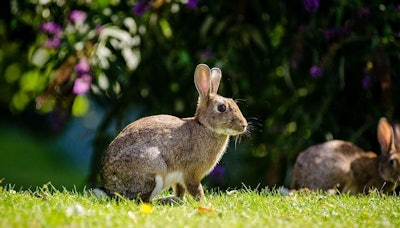
Yet if hungry pests have found the bulbs over the fall and winter or this spring once the shoots appeared, your clients will be sorely disappointed.
Certain landscaping companies like Cartwright Landscaping, based in Richmond, Virginia, and The Garden Kingdom, based in Glen Carbon, Illinois, don’t even fool with planting tulips anymore due to rabbits and other animals feasting on the bulbs.
“There’s tons of bunnies in our area and bunnies tear tulips up, so unless it’s a really protected area we don’t get into tulips too much,” Jeff Cartwright, owner of Cartwright Landscaping said.
While bulbs are beneficial for customers who want to have their garden set to bloom as spring arrived, they are also a tasty treat to numerous types of wildlife. Squirrels, chipmunks, rabbits, mice, voles, moles and deer are just some of the animals that that like to snack on flower bulbs.
Leonard Perry, an extension professor with the University of Vermont, says they are ‘the perfect lunch box,’ according to an article in The Christian Science Monitor.
Finding out specifically what sort of pests are eating your client’s bulbs will help you determine what is the best type of deterrent to use, but a combination of all the options tends to be the most effective.
Repellents
Repellents are a good method to use if your customers are still trying to protect the bulbs they currently have. These are not foolproof and will need to be replaced on a regular basis, as time and weather can reduce their effectiveness.
Blood meal is a standard repellent that can keep away small rodents while adding nutrients to the soil, but it can also attract other unwanted animals such as raccoons. Using predator hair or urine can also keep creatures away from clients’ bulbs. There are many chemical versions of these repellents that can be used as well.
Cayenne pepper’s smell and taste is another method that can discourage various rodents from nibbling on bulbs. To be particularly effective, advise your customers to soak their bulbs in repellent before planting this fall.
Protective barriers
If this season’s bulbs are already lost, you can advise your client on several different control methods for planting bulbs in the fall.
When planting the bulbs, homeowners can mix 10 percent sharp-edged gravel, stone dust or another gritty material to the soil as this will discourage digging rodents from going after their bulbs.
Chicken wire cages are a straightforward method for keeping most any animal out, though some may try to tunnel under. If rabbits are the main culprits, a 4-foot-tall chicken wire fence will do, though the bottom needs to be buried at least 10 inches deep and be bent with an L shape away from the garden. The mesh should be no larger than one inch.
Tulip alternatives
If your customers aren’t attached to growing tulips, one of the easier solutions you can offer is to plant bulbs that the majority of critters don’t want to bother eating.
Daffodils and snowflakes are avoided by rabbits due to the fact that they contain a poisonous substance called lycorine. Ornamental onions (Allium spp.) aren’t poisonous, but their taste is unappetizing to many animals.
Crocuses, Spanish bluebells, grape hyacinths, snowdrops and Siberian squill are other types of bulbs that you can install for customers that should have less of an issue being eaten in the spring.
Inter-planting tulips among some of these unsavory options can also provide a measure of safety for them.










